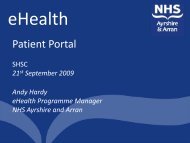Patient use of IT in mental health recovery â Mark Fleming
Patient use of IT in mental health recovery â Mark Fleming
Patient use of IT in mental health recovery â Mark Fleming
- No tags were found...
You also want an ePaper? Increase the reach of your titles
YUMPU automatically turns print PDFs into web optimized ePapers that Google loves.
<strong>Patient</strong> <strong>use</strong> <strong>of</strong> <strong>IT</strong> <strong>in</strong> MentalHealth Recovery<strong>Mark</strong> Flem<strong>in</strong>g- Cl<strong>in</strong>ical Development Manager
This Session• Drivers for change• Recovery models and pr<strong>in</strong>ciples• Basel<strong>in</strong>e evaluation• The project and benefits realisation• Relationship between Tidal model andEHealth• Evaluation and def<strong>in</strong>ed benefits
Why Change our way <strong>of</strong> work<strong>in</strong>g?• Duty to care for patients <strong>in</strong> secureenvironment.• Current model <strong>of</strong> cl<strong>in</strong>ical care was outdatedand not effective <strong>in</strong> relation to promot<strong>in</strong>g<strong>recovery</strong>• Pro-active staff and service <strong>use</strong>r group• National & Local drivers for change.
AimsPREDISPOSING• Equip <strong>in</strong>dividuals with knowledge about<strong>recovery</strong>• Change attitudes and values, so that<strong>recovery</strong> ideas are more central to rout<strong>in</strong>epractice• Encourage the development <strong>of</strong> specific skills<strong>in</strong> work<strong>in</strong>g with service <strong>use</strong>rs and theircarersENABLING• Promote work<strong>in</strong>g practices with<strong>in</strong> teamswhich enable <strong>in</strong>dividuals <strong>in</strong> liv<strong>in</strong>g their livesas well as possible
Tidal Pr<strong>in</strong>ciples• Value the voice• Respect the language• Become the apprentice• Use the available tool kit• Craft the step beyond• Give the gift <strong>of</strong> time• Develop genu<strong>in</strong>e curiosity• Know that change is constant• Reveal personal wisdom• Be transparentPoppy Buchanan-Barker and Phil Barker (2007)
Initial Evaluation Assessment• Technology did not encourage patient<strong>in</strong>teraction• Improved <strong>in</strong>volvement <strong>in</strong> care plann<strong>in</strong>grequired• Staff need to spend more time with patients<strong>in</strong> a therapeutic relationship.• Improve staff skills <strong>in</strong> assessment andmanagement <strong>of</strong> need and risk.
The Technology
Tablet Computers
Benefits <strong>of</strong> Tablet PC• Provides A Portable Means Of Interactionwhere both staff and service <strong>use</strong>rs can<strong>in</strong>put data <strong>in</strong> the privacy <strong>of</strong> low stimulienvironments.• Facilitates the transfer <strong>of</strong> data from aword/journal document onto electronic<strong>health</strong> records <strong>in</strong> FACE.
Digital Pens
Benefits <strong>of</strong> Digital pens• Are <strong>use</strong>d by service <strong>use</strong>rs to completediaries <strong>of</strong> DBT or Tidal based formatdocumentation on note pads provided.• Can be <strong>use</strong>d <strong>in</strong> privacy <strong>of</strong> area selected byservice <strong>use</strong>r.• Facilitate the transference <strong>of</strong> data to Facevia PC <strong>in</strong>terface.• Service <strong>use</strong>r can keep copy <strong>of</strong> writtenrecords.
Scanners
Benefits <strong>of</strong> Scanners• Allows those service <strong>use</strong>rs who documenton paper to have their stories and other<strong>in</strong>formation uploaded onto FACE.• Information that <strong>in</strong> the past was stored <strong>in</strong>a patients records <strong>in</strong> paper format cannow be accessed on FACE.
Laptop
Benefits <strong>of</strong> Mobile laptop• Service <strong>use</strong>rs can participate <strong>in</strong> thecompletion <strong>of</strong> their daily activity records,where they can witness and contribute to<strong>in</strong>formation be<strong>in</strong>g recorded if there current<strong>mental</strong> <strong>health</strong> allows.• It allows staff to record <strong>in</strong> an area that is notthe OFFICE and therefore permits optimumengagement with service <strong>use</strong>r.• Staff can <strong>in</strong>volve patients <strong>in</strong> and careplann<strong>in</strong>g activities on FACE system.
How does technology fit with TIDAL.• Values• Jo<strong>in</strong>t Ownership• Accuracy• <strong>Patient</strong> Centred Focus• Economy
Values• Service <strong>use</strong>r has Active Involvement <strong>in</strong> careprovision• The service <strong>use</strong>rs contributions are recognisedand respected.Phil barker and Poppy Buchanan-Barker 2007
Jo<strong>in</strong>t OwnershipThe jo<strong>in</strong>t ownership <strong>of</strong> this project develops• A sense <strong>of</strong> genu<strong>in</strong>e collaborationand• Helps to improve the therapeuticrelationship.Phil barker and Poppy Buchanan-Barker 2007
Accuracy <strong>of</strong> record<strong>in</strong>g <strong>in</strong>formation• The chances <strong>of</strong> distort<strong>in</strong>g <strong>in</strong>formationprovided by the service <strong>use</strong>r is reduced• Information is agreed and recorded by bothservice <strong>use</strong>r and nurse.Phil Barker and Poppy Buchanan- Barker 2007
Person centred focus• By record<strong>in</strong>g <strong>in</strong> the persons own words acommitment is shown to work<strong>in</strong>g with the<strong>in</strong>dividual.• Care plans and assessments are completed<strong>in</strong> collaboration with each other.Phil Barker and Poppy Buchanan-Barker 2007
Economy• Cl<strong>in</strong>ical Record<strong>in</strong>g sessions are live and takeplace with the patient.• The nurse saves time, which may otherwisewould have been spent <strong>in</strong> the <strong>of</strong>fice.Phil Barker and Poppy Buchanan-barker 2007
Post Evaluation• Formal Evaluation by cl<strong>in</strong>ical effectiveness• Evaluation had service <strong>use</strong>r perspectiveand staff perspective.
Service User Def<strong>in</strong>ed Benefits• Reduction <strong>in</strong> the <strong>use</strong> <strong>of</strong> constantobservations• Increased <strong>in</strong>volvement <strong>in</strong> care plann<strong>in</strong>gand MDT collaboration• Open Door Policy• Increase <strong>in</strong> available resources• Discharge from <strong>in</strong>-patient services tocommunity environments.
Successes• Improved service <strong>use</strong>r knowledge <strong>of</strong> keyworker• Improved service <strong>use</strong>r <strong>in</strong>volvement <strong>in</strong> careplann<strong>in</strong>g.• Improved service <strong>use</strong>r quality rat<strong>in</strong>g.• Improved satisfaction <strong>in</strong> deal<strong>in</strong>g withproblems.• Staff much more available• Improvement <strong>in</strong> care s<strong>in</strong>ce <strong>in</strong>troduction <strong>of</strong>technology
Results – Staff perspective• Improved <strong>use</strong> <strong>of</strong> FACE• Reduced time <strong>in</strong> record<strong>in</strong>g• Uptake <strong>of</strong> technologies by most staff• Good support <strong>of</strong>fered by e-<strong>health</strong> team• Some staff still feel they spend too much time onFACE. 50% improvement though.• Staff have more time to record <strong>in</strong>formation.• Much improved satisfaction <strong>of</strong> FACE system• 100% staff feel face has had some positive impact oncare.
System Slides
Questions





